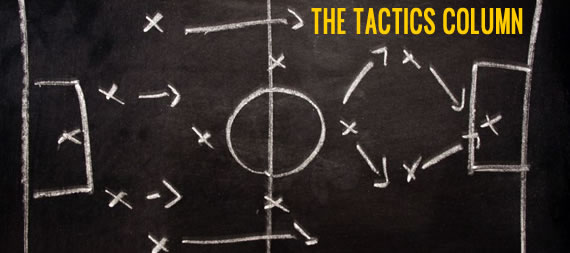The instinct with football teams and formations has always been to set them out symmetrically. That’s normal because you want to make sure every zone is covered without obvious bias or weakness. However, formations are neutral and it’s their application that decides their success and failures. And as such, balance is more important symmetry; one team might favour attack from one side more than another.
That was the case with Arsenal last season as they generally preferred to attack from the right-hand side in matches. Last season, 37% of their play came down the right flank while 30% came from the left. (The 33-34% of the rest originated from the middle). Arsenal had the runs of Theo Walcott to break out of the triangles they created while the use of a right-footed winger on the left meant play tended to slant anyway.
This season, the spread across the pitch is more even; with no overwhelming side which Arsenal favour (34% from the right; 32% in middle and 33% down left). That in itself might be significant because what this shows is that Arsenal are still finding how to play with each other.
For a while against Stoke City, it looked like Arsenal might profit from the left-side with Santi Cazorla and Lukas Podolski, in particular, linking up well while Kieran Gibbs added danger with his late bursts up the pitch. However, Arsenal tired and never made the most of such promising combinations. In the end, it looked like magic from Cazorla would be the most likely way for Arsenal to break through – it certainly was him in the first match against Sunderland – although Olivier Giroud did pass up the best opportunities in the two games.
But as we found out midway through last season, the biggest obstacle to fluency was when the full-backs were injured and while Arsenal’s defensive solidity has been heralded, the cautiousness of which the full-backs have been told to play this season, has affected the fluidity somewhat. In particular, Carl Jenkinson has failed to replicate Bakary Sagna’s availability in possession on the right (although his final ball is arguably better). It might not be so absurd to suggest Sagna could make a huge difference: last season, Arsene Wenger said the injury to full-backs, coupled with the fact that Arsenal were playing a three-striker system meant creativity remained mainly central. That’s what we are seeing now with this team.
INTERNATIONAL ARSENAL
Of course, there are other reasons for Arsenal’s struggles in front of goal, mainly the newness of the attacking players. It doesn’t, however, stop with Podolski, Giroud and Cazorla. Abou Diaby has rarely featured the past year while Jenkinson is also learning. Indeed, at the moment, one might say Arsenal are playing like an international side; there is lots of talent in the squad but they need more time to gel. As a result, perhaps, the defensive solidity is natural; when international teams first get together, it’s the first area that they pull towards getting right.
BEWARE OF SANTI BEARING GIFTS
It’s fair to say there are a lot of promising signs despite the lack of goals. Defensive organisation is as impressive as it’s been; certainly it can’t not coincide with the presence of Per Mertesacker who was nearly as impressive last season when Arsenal went through a run of eight games before winter unbeaten. Then his impact was understated because he looked out of place in the high-line – now one can point to the Steve Bould influence as a biggest factor for Arsenal’s improvement but the players deserve just as much praise for the execution.
In midfield, Mikel Arteta has been the hub which Arsenal builds play around while Cazorla has shone. But while the former is relishing the extra responsibility as vice-captain, Arsenal’s new signing from Malaga has probably arrived at the club with higher expectations than Andrey Arshavin. He’s already done what is required in the playmaker position but fans and critics alike still demand more. Cazorla’s seemingly this Zidane-Fabregas hybrid who should be driving with ball and dribbling past three or four players at the same time. A little understanding is required of his style; his dribbling is fantastic but he’s one who prefers to link play and drift around the pitch than charge with the ball as Fabregas did. Against Stoke, he preferred to drop deep and fans must accept that. But by doing so, it allows Diaby to push forward. It’s this dynamic which I feel Arsenal should make more of – it created two chances against Stoke.
COOL HAND LUKAS
“You can see something is missing,” said Wenger after the 0-0 draw at Stoke. “We are not spontaneous enough in some situations.” Normally, Robin van Persie would bail Arsenal out in such situations with his individuality and perhaps Olivier Giroud tried too hard to make an impression with his two spectacular efforts on Sunday. The French striker looks to have all the ingredients to play at the tip of the 4-3-3 but even though finishing has eluded him, Arsenal are probably unlucky to have faced two of the most deep-lying defences in the Premier League. As such, Giroud is probably the best option against those teams although it’s interesting, considering Wenger’s above statement, that he wanted Podolski to play there initially. The German offers perhaps the best chance of spontaneity and in the centre, he has an unorthodoxy of movement which might allow his fellow forwards inside. Spontaneity is why Wenger has gambled all his chips on Jack Wilshere’s return (and he will surely play as number 10). Nevertheless, expect plenty of rotation between Arsenal’s two main strikers.



